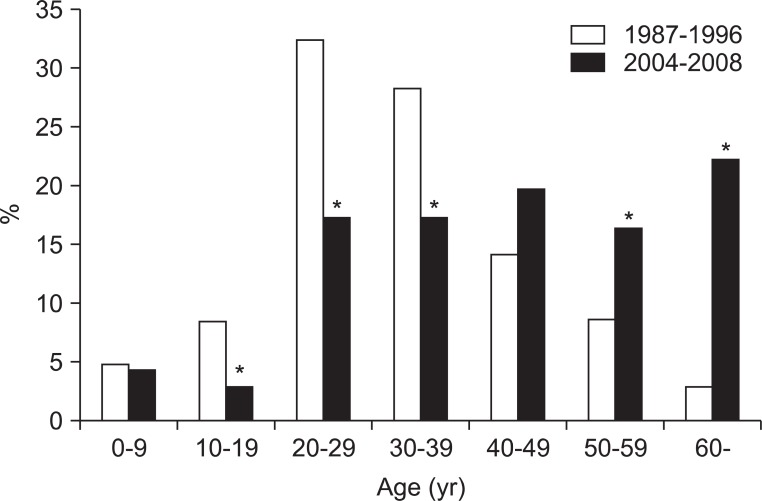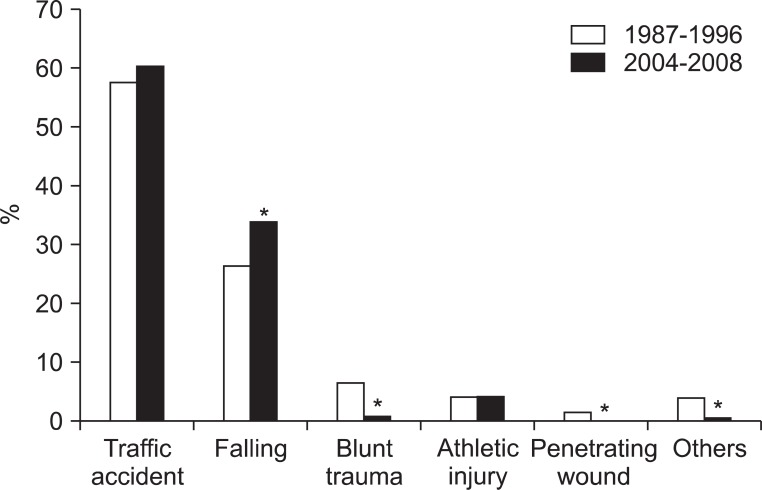Epidemiologic Change of Patients With Spinal Cord Injury
- Affiliations
-
- 1Department of Rehabilitation and Research Institute of Rehabilitation, Yonsei University College of Medicine, Seoul, Korea. fly_boy_f@hotmail.com
- 2Department of Rehabilitation Medicine, CHA Bundang Medical Center, CHA University, Bundang, Korea.
- KMID: 2266650
- DOI: http://doi.org/10.5535/arm.2013.37.1.50
Abstract
OBJECTIVE
To evaluate the epidemiologic change of patients with spinal cord injury who were admitted to a Rehabilitation Hospital, Yonsei University College of Medicine, during 1987-1996 and 2004-2008.
METHODS
Medical records of 629 patients with spinal cord injury admitted to the Rehabilitation Hospital, Yonsei University College of Medicine, from 2004 to 2008 were collected and reviewed retrospectively.
RESULTS
The male-to-female ratio decreased to 2.86:1, the mean age at injury increased, nontraumatic etiology increased, traffic accident remained to be the most common in traumatic spinal cord injury, and falling increased significantly. Tumor was the most common etiology in nontraumatic spinal cord injury, tetraplegia and incomplete injuries occurred more than paraplegia and complete injuries, indwelling catheter was the most common voiding method, and the duration of hospitalization decreased.
CONCLUSION
Many trends changed in epidemiology of spinal cord injury.
Keyword
MeSH Terms
Figure
Cited by 5 articles
-
Access to Medical Services in Korean People With Spinal Cord Injury
Jeong-Gil Kim, Hyung Seok Nam, Byungkwan Hwang, Hyung-Ik Shin
Ann Rehabil Med. 2014;38(2):174-182. doi: 10.5535/arm.2014.38.2.174.Effect of Robotic-Assisted Gait Training in Patients With Incomplete Spinal Cord Injury
Ji Cheol Shin, Ji Yong Kim, Han Kyul Park, Na Young Kim
Ann Rehabil Med. 2014;38(6):719-725. doi: 10.5535/arm.2014.38.6.719.Epidemiology of Spinal Cord Injury: Changes to Its Cause Amid Aging Population, a Single Center Study
Ha Seong Kim, Kil-Byung Lim, Jiyong Kim, Joongmo Kang, Hojin Lee, Sang Wan Lee, Jeehyun Yoo
Ann Rehabil Med. 2021;45(1):7-15. doi: 10.5535/arm.20148.Comparison of Trends in the Incidence of Traumatic Spinal Cord Injury in Daily Life, Automobile Accidents, and Industrial Accidents: A National Multi-Insurance Study in Korea
Yoonjeong Choi, Young-Eun Kim, Ja-Ho Leigh, Ye Seol Lee, Han-Kyoul Kim, You Gyoung Yi, Jinyoung Lee, Min-Yong Lee, Gangpyo Lee, Hyung-Ik Shin, Moon Suk Bang
J Korean Med Sci. 2023;38(7):e26. doi: 10.3346/jkms.2023.38.e26.Trends in the Incidence and Etiology of Non-Traumatic Spinal Cord Injury in Korea: A Nationwide Population-Based Study From 2007 to 2020
Yoonjeong Choi, Ja-Ho Leigh, Jooeun Jeon, Goo Joo Lee, Hyung-Ik Shin, Moon Suk Bang
J Korean Med Sci. 2023;38(18):e158. doi: 10.3346/jkms.2023.38.e158.
Reference
-
1. Devivo MJ. Epidemiology of traumatic spinal cord injury: trends and future implications. Spinal Cord. 2012; 50:365–372. PMID: 22270188.
Article2. Hagen EM, Eide GE, Rekand T, Gilhus NE, Gronning M. A 50-year follow-up of the incidence of traumatic spinal cord injuries in Western Norway. Spinal Cord. 2010; 48:313–318. PMID: 19823192.
Article3. Wyndaele M, Wyndaele JJ. Incidence, prevalence and epidemiology of spinal cord injury: what learns a worldwide literature survey? Spinal Cord. 2006; 44:523–529. PMID: 16389270.
Article4. Jackson AB, Dijkers M, Devivo MJ, Poczatek RB. A demographic profile of new traumatic spinal cord injuries: change and stability over 30 years. Arch Phys Med Rehabil. 2004; 85:1740–1748. PMID: 15520968.
Article5. DeVivo MJ, Chen Y. Trends in new injuries, prevalent cases, and aging with spinal cord injury. Arch Phys Med Rehabil. 2011; 92:332–338. PMID: 21353817.
Article6. Park CI, Shin JC, Kim SW, Jang SH, Chung WT, Kim HJ. Epidemiologic study of spinal cord injury. J Korean Acad Rehabil Med. 1999; 23:267–275.7. Nam YH, Juhn YS, Sung IY, Kang SK, Oh CH. Current status on 110 members in the Korean Welfare Association of spinal cord disabled. J Korean Acad Rehabil Med. 1985; 9:120–125.8. Ho CH, Wuermser LA, Priebe MM, Chiodo AE, Scelza WM, Kirshblum SC. Spinal cord injury medicine. 1. Epidemiology and classification. Arch Phys Med Rehabil. 2007; 88(3 Suppl 1):S49–S54. PMID: 17321849.
Article9. New PW, Simmonds F, Stevermuer T. A population-based study comparing traumatic spinal cord injury and non-traumatic spinal cord injury using a national rehabilitation database. Spinal Cord. 2011; 49:397–403. PMID: 20603631.
Article10. McKinley WO, Seel RT, Hardman JT. Nontraumatic spinal cord injury: incidence, epidemiology, and functional outcome. Arch Phys Med Rehabil. 1999; 80:619–623. PMID: 10378485.
Article11. Kuhn W, Zach GA, Kochlin P, Urwyler A. Comparison of spinal cord injuries in females and in males, 1979-1981 Basle. Paraplegia. 1983; 21:154–160. PMID: 6877853.
Article12. Citterio A, Franceschini M, Spizzichino L, Reggio A, Rossi B, Stampacchia G, et al. Nontraumatic spinal cord injury: an Italian survey. Arch Phys Med Rehabil. 2004; 85:1483–1487. PMID: 15375821.13. Exner G, Meinecke FW. Trends in the treatment of patients with spinal cord lesions seen within a period of 20 years in German centers. Spinal Cord. 1997; 35:415–419. PMID: 9232745.
Article14. O'Connor PJ. Forecasting of spinal cord injury annual case numbers in Australia. Arch Phys Med Rehabil. 2005; 86:48–51. PMID: 15640988.15. Ahoniemi E, Alaranta H, Hokkinen EM, Valtonen K, Kautiainen H. Incidence of traumatic spinal cord injuries in Finland over a 30-year period. Spinal Cord. 2008; 46:781–784. PMID: 18542095.
Article16. Chapman J. Comparing medical complications from nontraumatic and traumatic spinal cord injury [abstract]. Arch Phys Med Rehabil. 2000; 81:1264.
- Full Text Links
- Actions
-
Cited
- CITED
-
- Close
- Share
- Similar articles
-
- The Change of Total Ascorbic Acid Level in the Experimental Spinal Cord Injury
- Delayed Spinal Cord Injury Following Low Voltage Electrical Accident
- Spinal Cord Injury Followign Electrical Accidents : Case Reports
- Paraplegia Following Spinal Cord Contusion from an Indirect Gunshot Injury
- Spinal Cord Injury Rehabilitation (II): Management of Neurogenic Bladder




